Original title: Semiannual Report: 'Inside Hyperliquid's Growth'
Original source: GLC
Original translation by: Asher, Odaily Planet Daily
Editor's Note: In the first half of 2025, Hyperliquid continued to maintain its leading position in the decentralized perpetual contract market, with the platform's TVL, open interest, and trading volume all hitting record highs. The HyperEVM ecosystem rapidly expanded, Unit drove the implementation of spot trading, and local applications and Builder Codes accelerated user growth. The HYPE token performed steadily under the support of a unique buyback mechanism and record revenues, while HIP-3 opened deployment permissions for the perpetual market, bringing new profit opportunities to the community. With strategic partners joining and more assets being put on-chain, Hyperliquid has significant growth potential in the second half of the year, shaping a new landscape for decentralized trading.
Hyperliquid on-chain metrics
TVL and fund inflow volume
The launch and airdrop of the HYPE token did not lead to a loss of users. On the contrary, Hyperliquid began to experience remarkable growth starting from Q4 2024. Notably, the inflow of funds surged in November, with daily peaks exceeding $50 million, driving the TVL from $564 million to over $2 billion, with a quarterly growth rate of up to 269%.
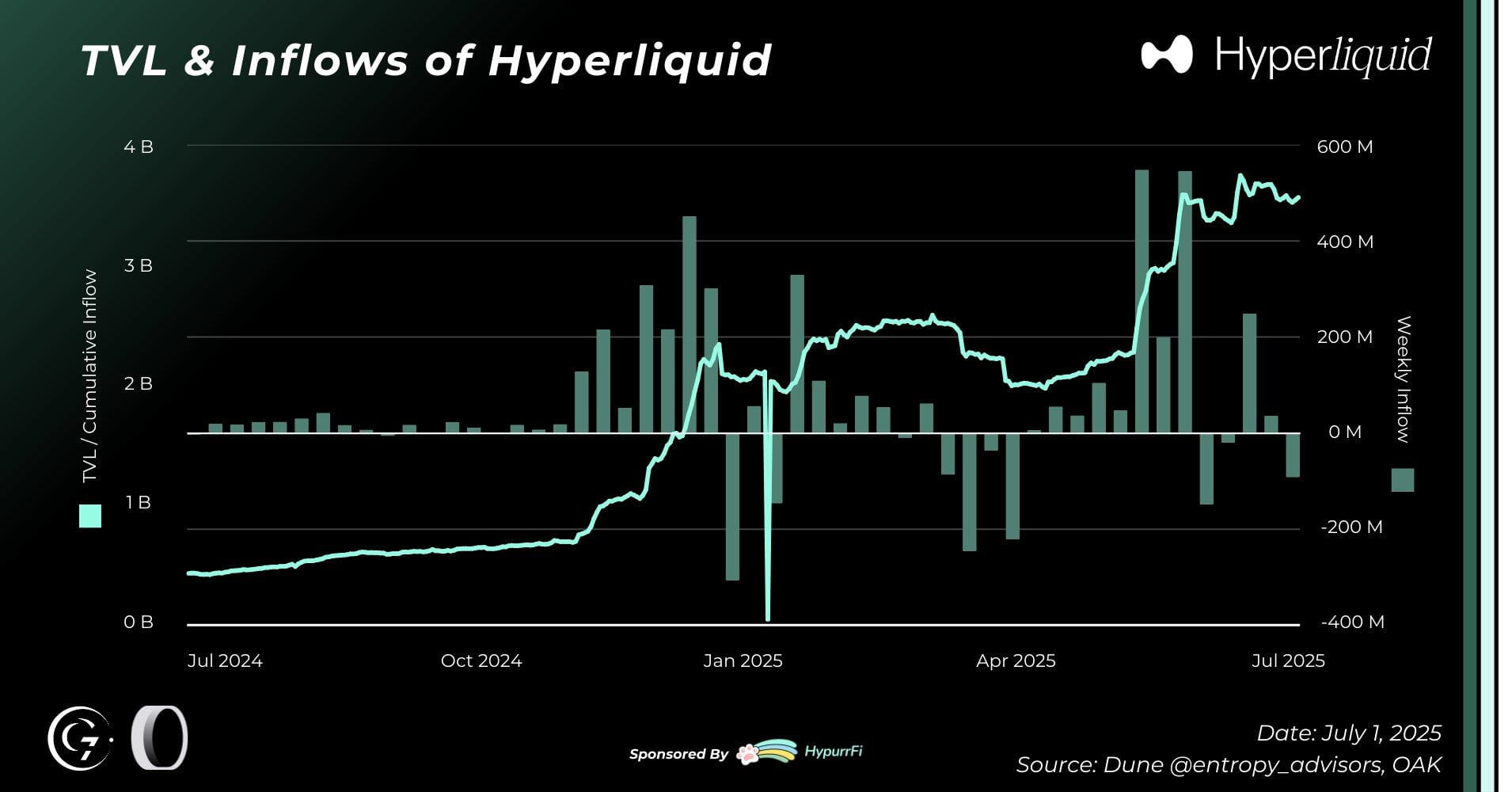
Due to continuous growth, Hyperliquid further solidified its dominant position in the decentralized perpetual contract trading space in the first half of 2025. As of June 30, the platform's TVL reached $3.5 billion, a 70.8% increase from $2.1 billion at the beginning of the year. During the same period, despite experiencing a net outflow impact of $590 million in March, overall fund inflows remained strong, averaging a net inflow of $58 million per week.
Open interest volume and trading volume
From Q4 2024, when it first broke $1 billion, to the end of the year, Hyperliquid's open interest grew by approximately 227% in just a few months, reaching $15 billion as of 2025, a year-on-year increase of about 359% compared to the end of 2024, equivalent to 61% of ByBit, 105% of OKX, and 120% of Bitget.
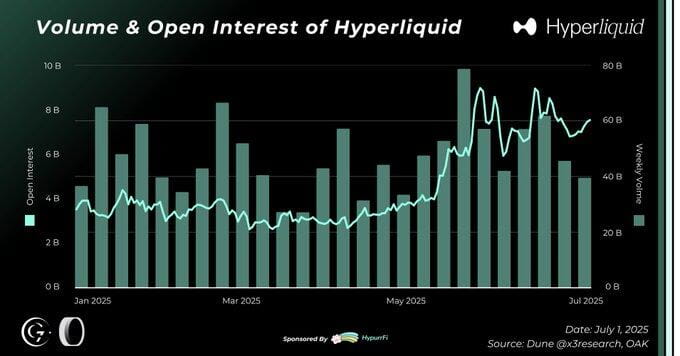
In Q4 2024, Hyperliquid's weekly trading volume was approximately $13 billion. This significantly increased to an average of $47 billion in the first half of 2025, peaking at a historic high of $78 billion in the week of May 12. Meanwhile, its market share also expanded, rising from about 56% at the end of 2024 in the decentralized perpetual contract trading platform to over 73% at the end of Q1 2025, further consolidating its industry-leading position.
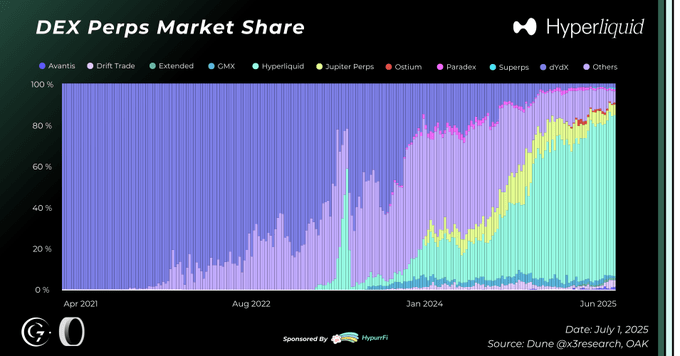
In terms of user scale, the number of user addresses on Hyperliquid grew from 291,000 to over 518,000 in the first half of 2025, an increase of 78% over six months. This growth not only reflects the rapid expansion of the platform's user base but also corresponds to over $53 billion in liquidated positions, demonstrating the market's activity and depth.
Comparison of Hyperliquid and CEX data
In the first half of 2025, Hyperliquid's growth relative to centralized exchanges (CEX) was particularly notable. As of now:
· Hyperliquid's trading volume accounts for 6.1%, an increase of 3.9 percentage points since January.
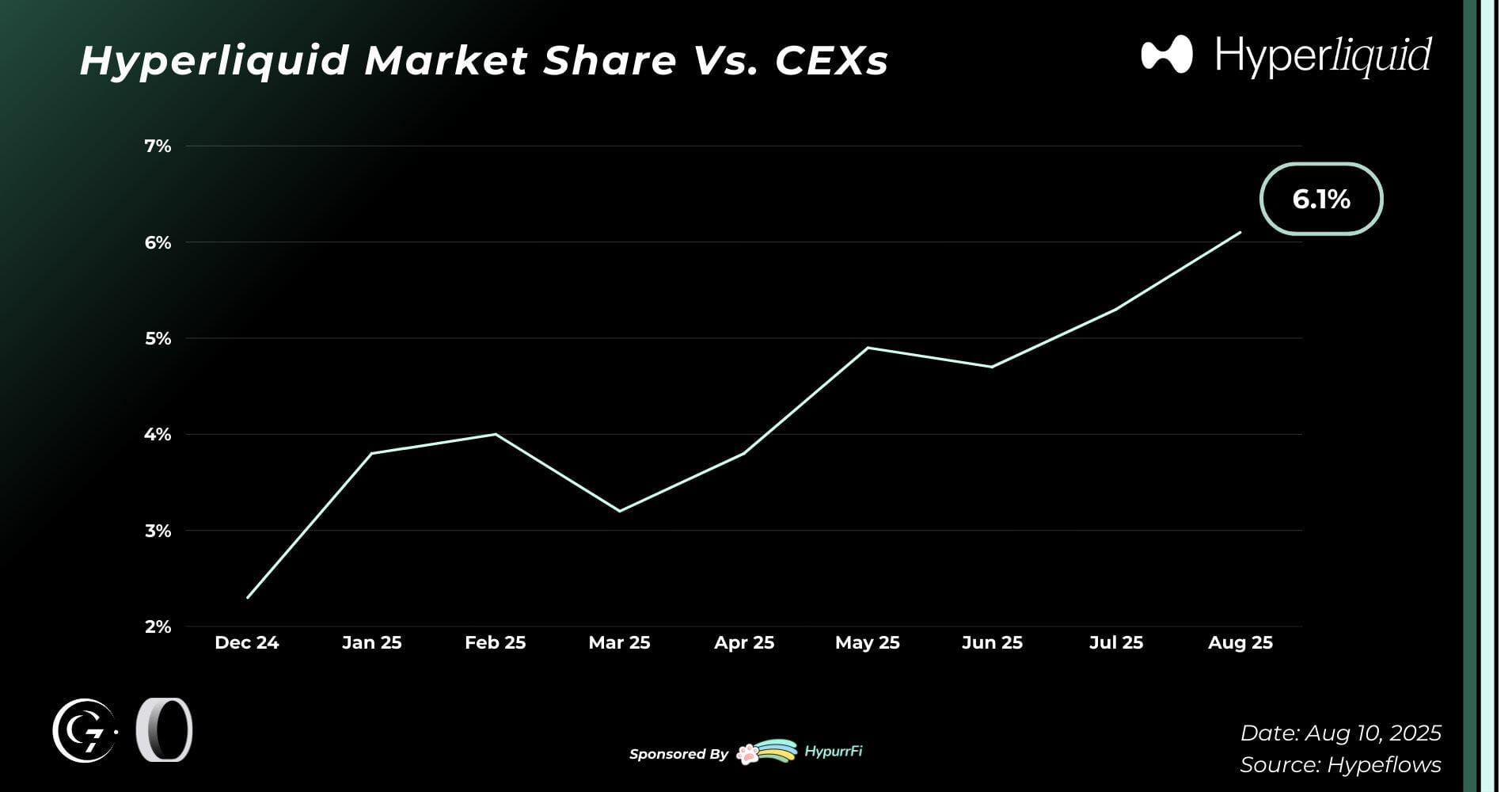
· Hyperliquid's open interest accounts for 17.8%, an increase of 12.3 percentage points since January.
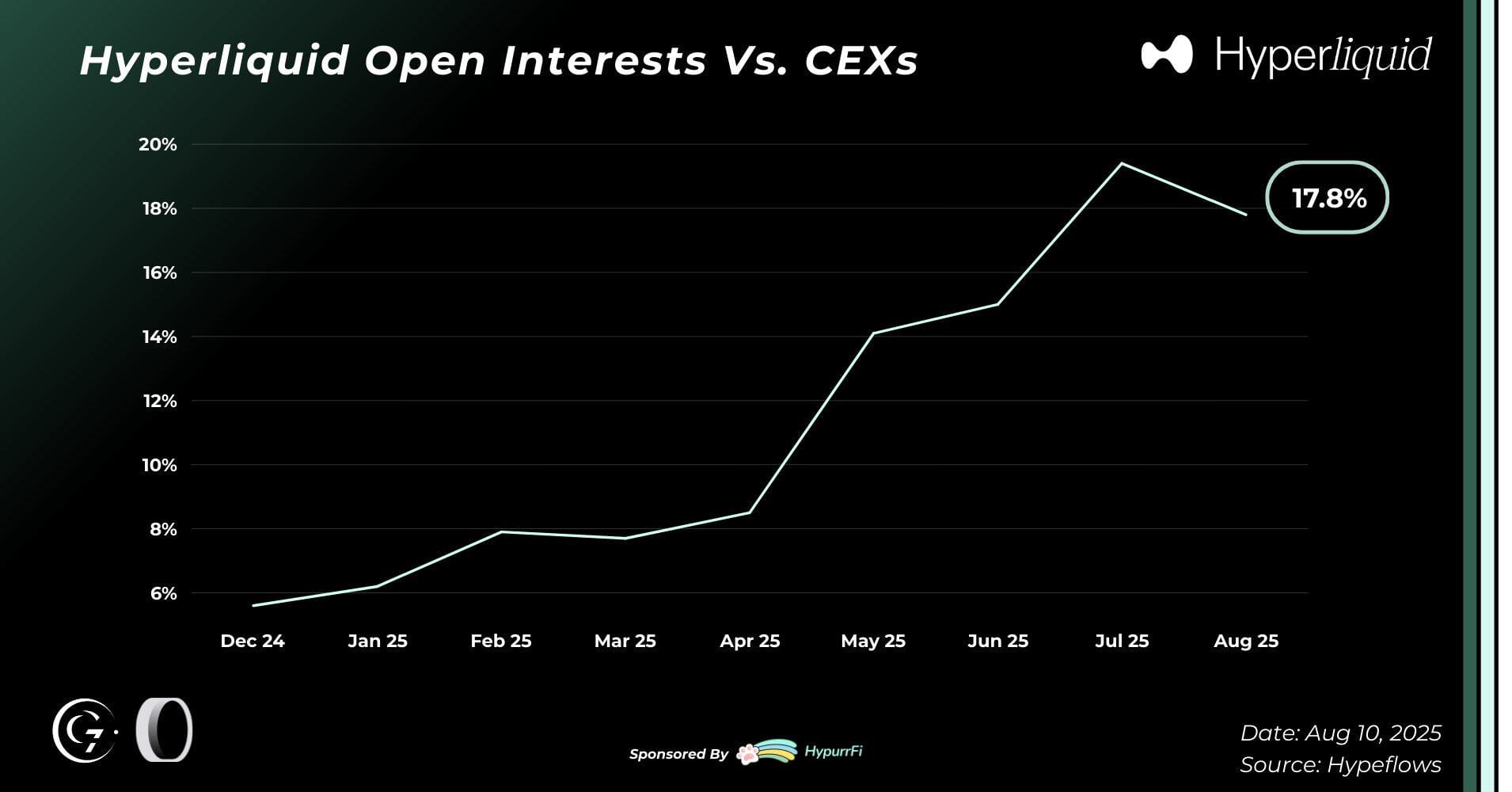
Firstly, Hyperliquid has the lowest cost for trading spot and perpetual contracts in the ecosystem while providing deep on-chain liquidity. For certain assets, the order book depth can now rival that of leading CEXs. For example, during the PUMP launch period, the platform achieved the deepest market depth, highest trading volume, and tightest bid-ask spread, marking a historic first for DEXs.
Secondly, Hyperliquid has become the preferred platform for the launch of new coins. Since the launch of Trump coin, the platform has continuously led in the launch of perpetual contracts, a strategy that quickly attracted users and reinforced the platform's recognition as the preferred choice for new coin trading. Moreover, PUMP raised approximately $500 million in just 12 minutes, making Hyperliquid the first platform to simultaneously launch spot and perpetual contracts while providing pre-trade opportunities, validating its ability to acquire users and liquidity.
Today, Hyperliquid can match leading CEXs in terms of trading speed, liquidity, and user experience while retaining decentralized advantages: permissionless access, on-chain transparency, and natively composable, allowing any asset, position, or trade to integrate directly with smart contracts, dApps, or other protocols on HyperEVM.
HLP: Core liquidity engine and robust returns
HLP (Hyperliquidity Provider) is Hyperliquid's core liquidity engine, providing USDC liquidity for order books, market making, and automated liquidation, while integrating various strategy yields to provide users with non-directional exposure. HLP's TVL surged at the end of 2024, driven by HYPE airdrops, increasing from $150 million at the end of November to over $400 million at the beginning of 2025, peaking at $512 million in May, maintaining stability in the first half of the year and ultimately closing at $372 million.
During the same period, HLP's net profit rose from $50 million to $68 million, with users achieving an average annualized return of approximately 11%. Despite the occurrence of the JELLY incident, the net yield for the first quarter of 2025 remained at 5.2%, with a decline of less than 3.5%.
Unit: The key to Hyperliquid's future
Unit went live on February 14, 2025, as Hyperliquid's asset tokenization layer, supporting native deposits and withdrawals for various assets, and directly listing assets on the Hyperliquid spot market through an auction system, initially supporting BTC and later expanding to ETH, SOL, FARTCOIN, PUMP, BONK, and more.
Since its launch, Unit's TVL has reached $800 million, second only to Kinetiq; in the first half of the year, asset volume traded through Unit exceeded $15 billion. Nevertheless, Hyperliquid's spot trading volume still accounted for only 2% of the overall trading volume, far below the 15%-30% ratio of most centralized exchanges, indicating it is still in the early stages.
HyperEVM on-chain metrics
HyperEVM went live in February 2025, this blockchain is EVM-compatible and built directly on Hyperliquid's infrastructure, supporting the deployment of smart contracts and decentralized applications.
TVL
Although the TVL was less than $50 million at the beginning of February, just two months after the mainnet deployment (mid-April), the TVL surpassed $1 billion and reached $2.08 billion by June 30, achieving a doubling growth.
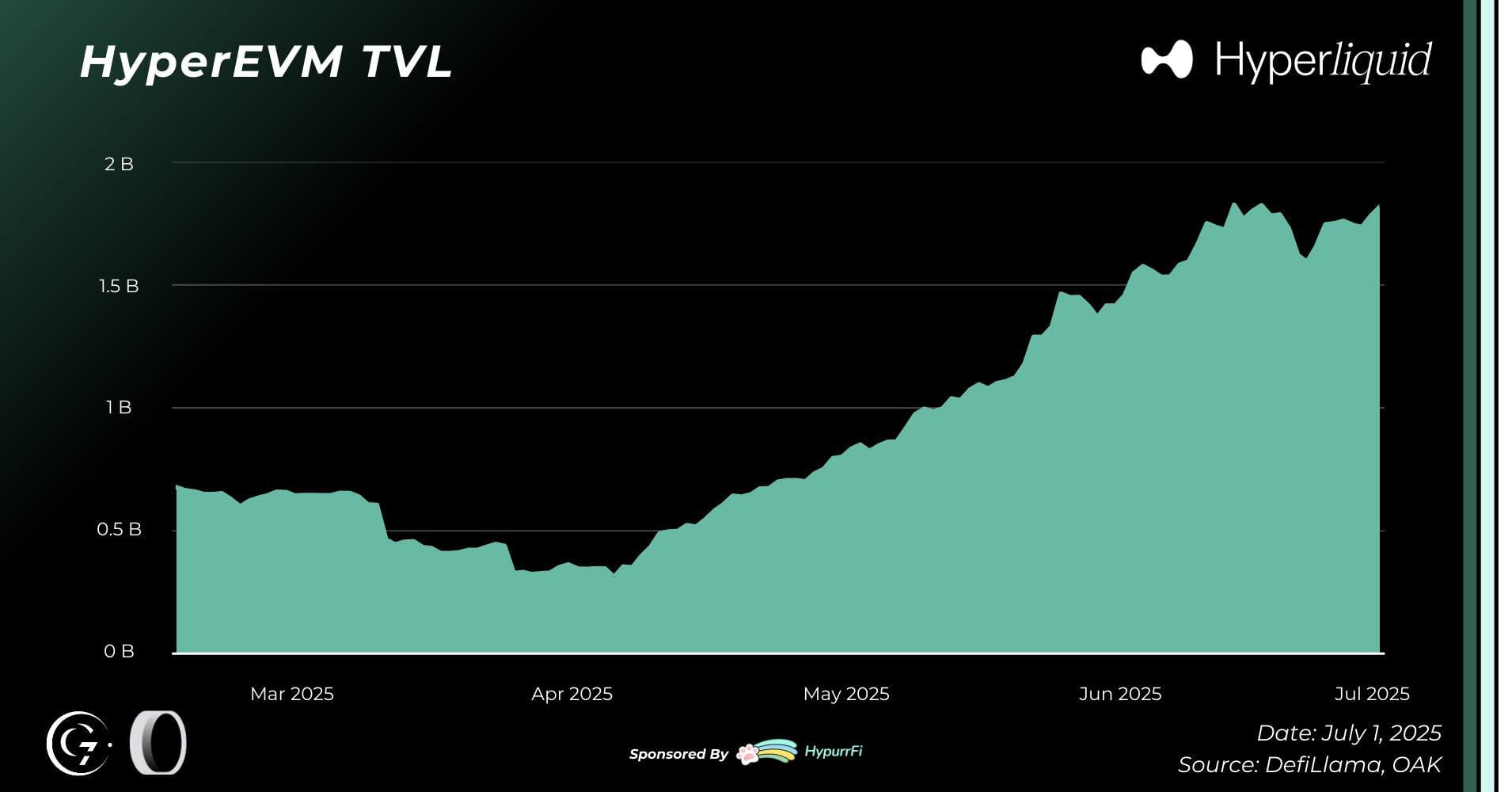
Number of active addresses
In the first half of 2025, user activity on HyperEVM steadily increased, with an average of about 33,000 active addresses per day, peaking at over 44,000 in June.
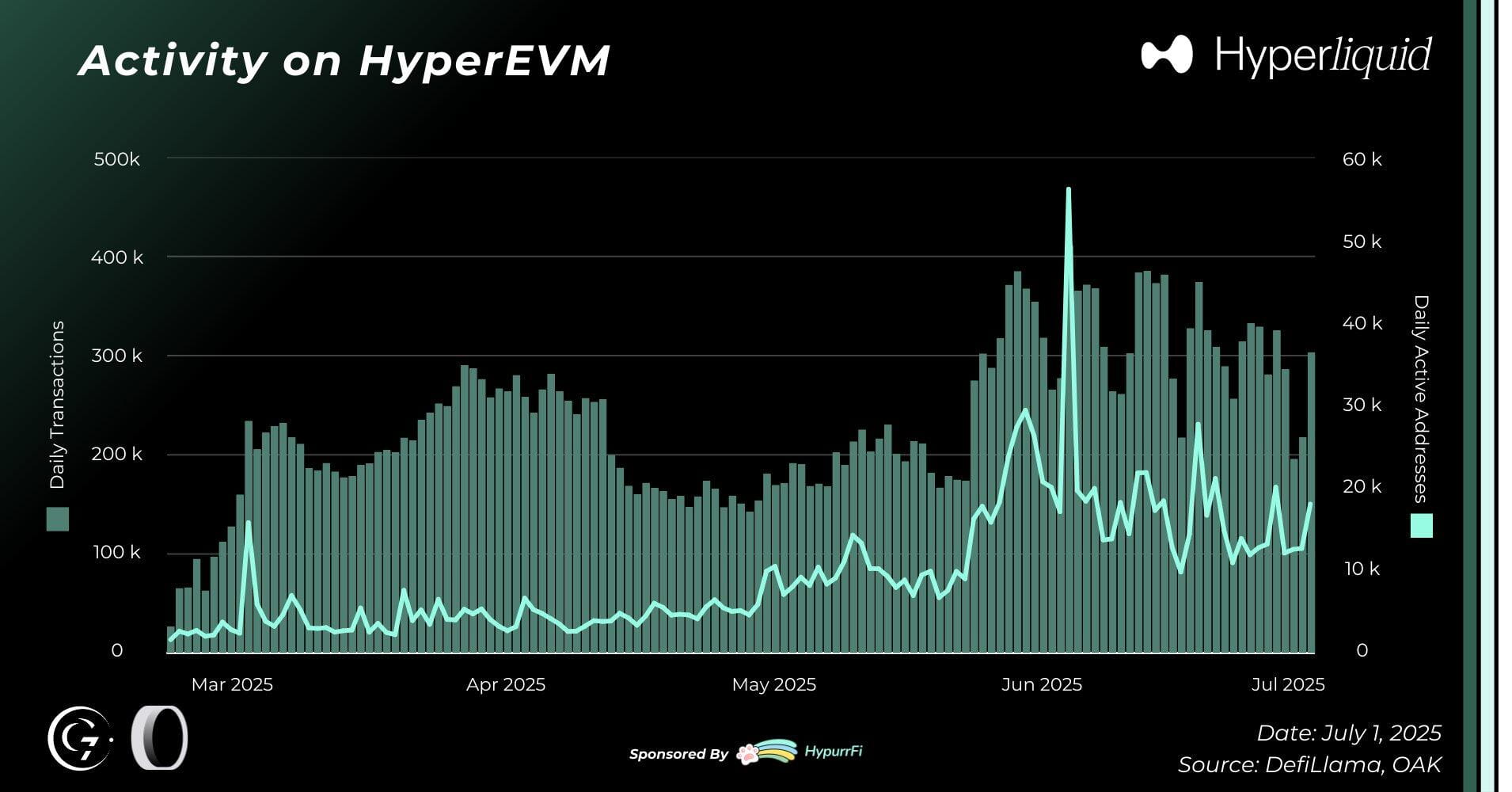
Moreover, trading volume followed a similar trend, averaging about 208,000 trades per day, peaking at 315,000 trades.
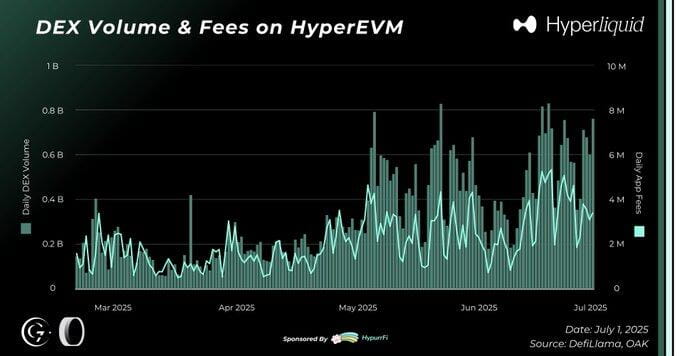
In terms of economic performance, applications on HyperEVM generate an average of about $1.927 million in fees daily, peaking at $4.855 million on May 21, with total fees accumulated to date reaching $256.2 million.
HYPE income and buybacks
Unlike most DeFi protocols, the Hyperliquid team does not directly take platform fees; all income is distributed to HLP and the Assistance Fund. HLP is a community treasury, providing market-making profits to users; the Assistance Fund is priced in HYPE and acts as a liquidity reserve when needed.
Recent data indicates that about 92% of fees flow to the Assistance Fund, with the remaining 8% allocated to HLP. The Assistance Fund uses income from the HYPE buyback program to repurchase tokens in the spot market, thereby supporting the HYPE price and directly benefiting token holders.
Since the beginning of 2025, Hyperliquid's total revenue reached $406 million (annualized over $810 million), making it one of the most profitable protocols in the crypto industry, second only to Tether and Circle. Fees in the first quarter saw significant growth, rising from about $1 million per day to an average of $3 million, with peaks exceeding $5 million.
Additionally, the Assistance Fund can repurchase approximately 13% of HYPE's supply annually. With the launch of HIP-3 and Builder Codes (represented by Phantom), Hyperliquid's fees will further increase, strengthening the buyback model and supporting token value (at the time of writing, based on data from the past 30 days, the annualized revenue is approximately $1 billion, translating to a price-to-earnings ratio of about 15 based on circulating supply).
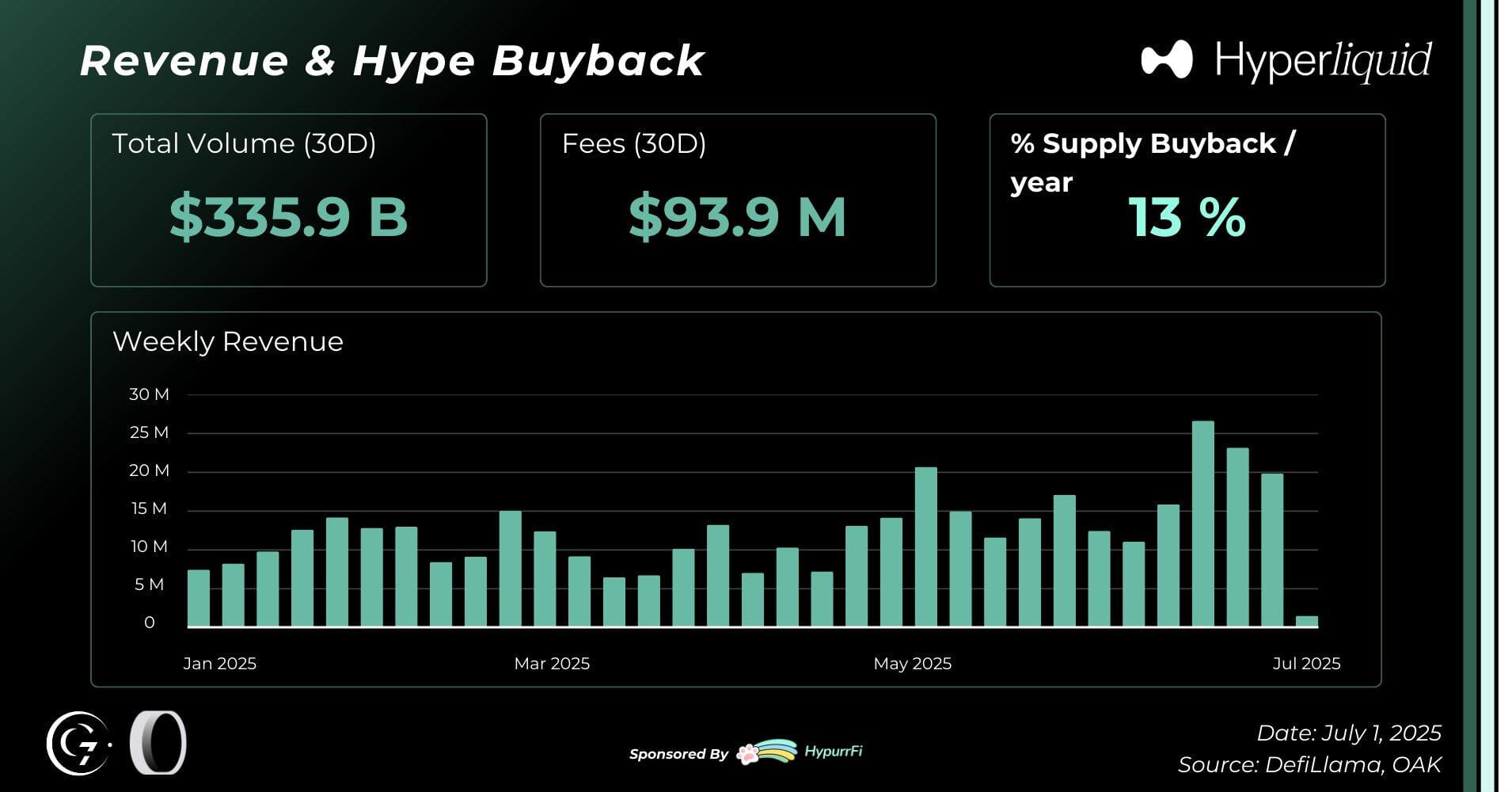
Key events for Hyperliquid in the first half of the year
In January 2025, Hyperliquid expanded its validators to 27 and launched the TRUMP perpetual contract, with trading volume exceeding $21 billion for two consecutive days.
In February 2025, Unit went live, achieving a native asset recharge of $400 million and a spot trading volume of $8.4 billion; HyperEVM launched, with a TVL of $2 billion.
In March 2025, the Jelly incident caused HLP losses of $12 million, and users were compensated.
In May 2025, the HIP-3 testnet allowed the community to deploy new perpetual markets, while also launching Staking Tiers and introducing stablecoins USDe and USDT0.
In June 2025, several listed companies included HYPE in their corporate treasury, and Hyperliquid's annualized revenue exceeded $800 million, with 97% used for HYPE buybacks.
In July 2025, CoreWriter went live, achieving bidirectional write capabilities for HyperCore and HyperEVM. Builder Codes integrated Phantom Perps, adding approximately 20,000 users, with expected annual revenue of $15 million to $30 million.
Summary
In the first half of 2025, Hyperliquid continued to strengthen its leadership position in the decentralized perpetual contract market, with outstanding on-chain metrics, accelerated adoption of HyperEVM, and rapid expansion of the local application ecosystem. Supported by a unique buyback mechanism and record revenues, the HYPE token performed steadily, showcasing the sustainability of the protocol's economic model.
More broadly, Hyperliquid is continuously opening new growth spaces by strengthening liquidity and infrastructure advantages while promoting the development of HIP-3, CoreWriter, and Builder Codes. With the joining of strategic partners like Phantom and the rise of HyperEVM's native protocols, the network has robust growth potential in the second half of the year.
Among them, HIP-3 is the core driving force: any user holding 1 million HYPE can deploy perpetual contracts and earn up to 50% of trading fee revenues, without bearing infrastructure costs, as Hyperliquid provides full support. The integration of Phantom has already shown results, with this alone expected to bring a 2%-4% annual cash flow increase; if more wallets or front ends follow suit, the potential will be further amplified.
With the U.S. SEC launching a new on-chain asset program, Hyperliquid is expected to support more asset types, unlocking further growth opportunities.
Original link



